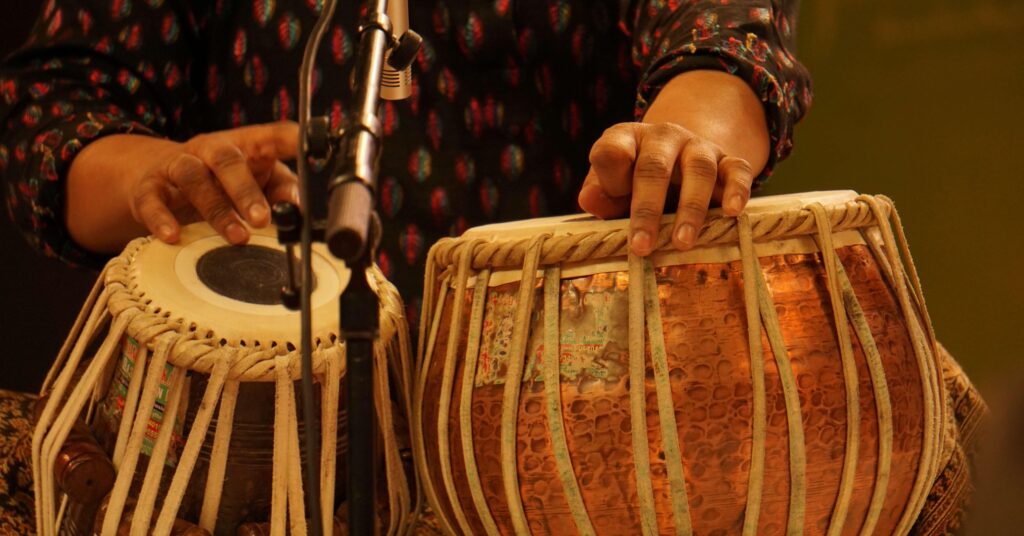Are you curious to know what is taal? You have come to the right place as I am going to tell you everything about taal in a very simple explanation. Without further discussion let’s begin to know what is taal?
Taal, often referred to as “rhythm” or “beat,” is a foundational element in the rich tapestry of Indian music and culture. In the vast and diverse world of Indian music, Taal is the rhythmic framework that provides structure and cohesion to compositions, dances, and musical performances. In this blog, we will explore what Taal is, its significance in Indian music, and how it weaves into the fabric of the country’s cultural heritage.
What Is Taal?
Taal is a fundamental concept in Indian classical music and dance. It refers to the rhythmic cycle or time measure that organizes musical compositions and dance sequences. Taal encompasses a structured pattern of beats or time units that repeat cyclically, creating the rhythmic foundation for the performance.
Key Aspects Of Taal:
- Taal Structure: A Taal is characterized by a specific number of beats organized into groups. Each beat is referred to as a “matra,” and the groups are known as “vibhags” or “avartans.”
- Bols: The beats within a Taal are vocalized using mnemonic syllables called “bols.” These syllables help in memorizing and performing complex rhythms.
- Theka: The “theka” is the basic pattern of bols that defines a Taal. It provides the primary rhythmic structure of the Taal.
- Sam: The “sam” is the first beat of the Taal cycle and is often marked by a clap or another distinctive sound. It serves as the reference point for the entire rhythm.
Significance Of Taal In Indian Music
- Structural Framework: Taal provides the structural framework for musical compositions, enabling musicians and dancers to create and perform intricate pieces with precision.
- Emotional Expression: The manipulation of Taal allows artists to convey a wide range of emotions and moods through rhythmic variations.
- Collaboration: Taal serves as a common language for musicians and dancers, allowing them to collaborate seamlessly in group performances.
- Improvisation: Indian musicians often incorporate improvisation within the confines of a Taal, adding creativity and spontaneity to their performances.
- Cultural Identity: Taal is deeply ingrained in Indian culture and tradition, contributing to the identity and uniqueness of various musical genres, such as Hindustani and Carnatic classical music.
Let’s find some more interesting topics like these here askcorran.
Popular Taals In Indian Music
Indian music boasts a diverse array of Taals, each with its own unique structure and characteristics. Some of the well-known Taals include:
- Tintal (Teen Taal): Comprising 16 beats organized into four vibhags, Tintal is one of the most widely used Taals in North Indian classical music.
- Ektaal: Ektaal consists of 12 beats grouped into six vibhags. It is often used for performances with a slower tempo.
- Jhaptal: Jhaptal features 10 beats in a cycle, organized into four vibhags. It is known for its graceful and flowing rhythm.
- Rupak Taal: With a distinctive pattern of seven beats, Rupak Taal is often used in semi-classical and devotional music.
- Keharwa Taal: Keharwa is a popular Taal with an eight-beat cycle, widely used in folk music and light classical compositions.
Conclusion
Taal is the rhythmic heartbeat of Indian music and culture, providing structure, depth, and character to artistic expressions. Its significance extends beyond the boundaries of classical music and dance, influencing diverse genres and art forms. The intricate patterns of Taal, the art of improvisation within its framework, and the emotional resonance it conveys make it an integral part of India’s rich cultural heritage. It continues to captivate and inspire artists and audiences alike, celebrating the timeless beauty of rhythm and melody.
FAQ
What Is Called Taal?
Taal is a cycle of beats. Beats are referred to as Matras in Indian classical music. Each beat/ matra is represented with the help of syllables that are equidistant from each other. One cycle of beats is called Avartan.
What Is Taal In India?
In Sanskrit, the word Taal means ‘to strike with palms’. In Tamil, Taalam means ‘to clap’. In Hindi, the word means ‘beat’ and in Bengali, besides rhythm the word Taal also means sanity. Taal is a beat cycle. In Indian classical music, beats are known as matras.
What Is Taal And Raag?
Hindustani classical music is developed through two interwoven elements: raga and tala. Raga is the melodic element and is crafted by improvisation on fixed patterns of ascent and descent. Conversely, tala is the rhythmic structure on which the melody is laid.
What Is Taal Class 11?
Taal (Tala) is the regular rhythmic pattern of equally placed beats of any composition. The word Taal literally means ‘a clap.
I Have Covered All The Following Queries And Topics In The Above Article
What Is Taal In Music
What Is Taal In Music In Hindi
What Is Taal In Kathak
What Is Taal In Dance
Definition Of Taal In Music
What Is Taal In English
What Is Taal In Dance
What Is Taal Guitar
What Is Taal Rhythm
What Is Laya
What Is Taal In Hindi
Definition Of Taal In Music In English
What Is Taal
What is Taal in India







